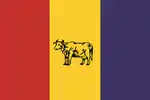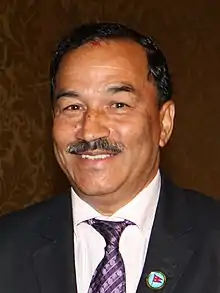Rastriya Prajatantra Party
The Rastriya Prajatantra Party (Nepali: राष्ट्रिय प्रजातन्त्र पार्टी [ˈrasʈrijʌ prʌˈd͡zatʌntrʌ ˈpa(r)ʈi]; translation: National Democratic Party; abbr. RPP) is a monarchist and Hindu nationalist political party in Nepal. It was formed by former Prime Ministers, Surya Bahadur Thapa and Lokendra Bahadur Chand. The party has had two Prime Ministers, Thapa and Chand, serving two terms each since the end of the Rastriya Panchayat.
Rastriya Prajatantra Party राष्ट्रिय प्रजातन्त्र पार्टी | |
|---|---|
| Abbreviation | RPP |
| Chairperson | Kamal Thapa Pashupati SJB Rana Prakash Chandra Lohani |
| Founded | 29 May 1990 |
| Headquarters | Charumati Bihar, Chabahil, Kathmandu, Nepal[1] |
| Student wing | National Democratic Student's Union Nepal |
| Youth wing | National Youth Front |
| Women's wing | National Democratic Women's Union |
| Ideology | Hindutva[2] Hindu nationalism[3] National conservatism Constitutional monarchism Economic liberalism |
| Political position | Centre-right to right-wing |
| International affiliation | Asia Pacific Democrat Union |
| Seats in Pratinidhi Sabha | 1 / 275
|
| Seats in Provincial Assemblies | 1 / 93 (Province No. 1)2 / 110 (Bagmati Province)1 / 40 (Karnali Province)
|
| Election symbol | |
 | |
| Party flag | |
 | |
| Website | |
| rpp | |
History
Founding and early years, 1990-1991
The Rastriya Prajatantra Party was formed by the ruling elite of the Panchayat era on May 29, 1990. The party split in 1991 over technical differences and two parties bearing the same name, ideology and statute came into existence. The two parties one led by Surya Bahadur Thapa and the other led by Lokendra Bahadur Chand contested the 1991 elections. The two parties did not perform as expected, Thapa's party winning 1 seat and Chand's party winning 3 seats, and the two parties decided to merge again.[4]
First general convention, 1992-1994
The party held its first general convention on 1992 in Kathmandu and unanimously elected Surya Bahadur Thapa as its chairman. Lokendra Bahadur Chand and Rajeshwor Devkota were elected leader and co-chairman respectlively.[4]
In the 1994 elections, the party received 18 percent of the votes and won 20 seats to the House of Representatives, making them the third largest party in the parliament. No other party got a majority and the party joined coalition governments with Communist Party of Nepal (Unified Marxist–Leninist) and Nepali Congress successively.

Second split, 1997-1999
In 1997 the party split after a faction led by Lokendra Bahadur Chand joined a coalition government with Communist Party of Nepal (Unified Marxist-Leninist), with Chand as Prime Minister. The faction led by Surya Bahadur Thapa allied itself with Nepali Congress and toppled the government. The party expelled Lokendra Bahadur Chand and nine supporters for threatening to back a no-confidence motion against the Thapa led government and Chand started his own party. The second general convention of the party took place in 1998 in Birgunj with Surya Bahadur Thapa again becoming chairman. Prakash Chandra Lohani, Pashupati SJB Rana and Kamal Thapa were nominated as vice-chairman, general secretary and spokesman respectively.[4]
The two parties contested the 1999 elections and fared badly in the election with the partly led by Surya Bahadur Thapa winning 11 seats and the party led by Lokendra Bahadur Chand not winning any seats. Following the elections the parties decided to merge again.[4]
King's rule and Mass Movement II, 2002-2006
After the king dismissed the government led by Sher Bahadur Deuba on October 2002, Lokendra Bahadur Chand was appointed Prime Minister but he resigned in May 2003 and was replaced by Surya Bahadur Thapa.
At the third general convention of the party held in Pokhara on December 2002, Surya Bahadur Thapa retired from his post as party chairman (which was mandatory according to the party constitution, as he had served two four-year terms). Pashupati SJB Rana was elected chairman during the convention and Padam Sundar Lawati, Kamal Thapa and Roshan Karki were nominated vice-president, general secretary and spokesperson respectively.[4]
The party on December 2003 called for Surya Bahadur Thapa to resign as Prime Minister for undermining people's multiparty democracy and he eventually resigned on May 2004. The party split again in March 2005 when former party president Surya Bahadur Thapa broke away and formed a new centre-right liberal party, the Rastriya Janashakti Party.[5]
When the King dissolved the parliament and started his own rule in 2006, the party announced their support for the pro-democracy agitation led by the Seven Party Alliance but ten members of the party's central committee, including spokesperson Kamal Thapa, supported the King. The party members were expelled, including six cabinet ministers, and they eventually formed their own party, the royalist Rastriya Prajatantra Party Nepal, led by Kamal Thapa.[5]

Constituent Assembly, 2007-2015
When the Interim-Legislature Parliament was formed under the leadership of Girija Prasad Koirala, the party had nine seats becoming the largest opposition party. In the 2008 elections the party won 8 seats to the Constituent Assembly of Nepal through the party-list proportional representation system.[5] The party joined the Madhav Kumar Nepal led government on June 2009.
In May 2013, the Rastriya Janashakti Party merged with the Rastriya Prajatantra Party, with Surya Bahadur Thapa leading the party. The party won 13 seats in the 2013 elections, 3 first past the post and 10 party-list proportional representation seats, becoming the sixth largest party in the 2nd Constituent Assembly. The support for the Communist Party of Nepal (Unified Marxist–Leninist)-Nepali Congress coalition government earned the party two portfolios in the new cabinet.[6]

Unification and splits, 2016-present
On 21 November 2016, Rastriya Prajatantra Party Nepal and Rastriya Prajtantra Party announced their unificaion. The new party retained the name of Rastriya Prajatantra Party. The new party had a total strength of 37 in the Parliament of Nepal, becoming the fourth largest party.[7] Kamal Thapa was elected chairman of the party in a special general convention in Kathmandu on February 2017.[8] The party split again due to differences in selecting the electoral symbol of the party and Dr. Prakash Chandra Lohani formed a new party, the Unified Rastriya Prajatantra Party (Nationalist) on March 29, 2017.[9] Another split occurred after Pashupati SJB Rana broke away forming Rastriya Prajatantra Party (Democratic).[10] In the 2017 legislative and provincial elections, Rastriya Prajantatra Party formed an alliance with Nepali Congress and Rastriya Prajatantra Party (Democratic).[11] The party only won one seat to the House of Representatives with only Rajendra Lingden being elected.[12] The party also could not become a national party after failing to pass the three percent threshold in proportional representation.[13] The party also won one seat each to provincial assemblies of Province No. 1, Province No. 3 and Province No. 6.[14]
The Rastriya Prajatantra Party (Samyukta) merged with the party on March 12, 2020 with Kamal Thapa, Pashupati SJB Rana and Dr. Prakash Chandra Lohani all acting as chairs.[15]
Ideology
The Rastriya Prajatantra Party was established as an alternative force to the major political parties, Nepali Congress and Communist Party of Nepal (Unified Marxist–Leninist). The party was founded on the principles of democracy, constitutional monarchy, nationalism and economic liberalism.[16][17][18] When the monarchy was abolished in 2008 and Nepal was declared a secular state, the Rastriya Prajatantra Party Nepal changed its constitution to support monarchy and the re-establishment of the Hindu state.[19] After the merger between the two parties it was announced that the Rastriya Prajatantra Party would take up the constitution of Rastriya Prajatantra Party Nepal.[7] The party has stated support for a Hindu state with religious freedom and registered an amendment proposal for such on March 19, 2017.[20]
Electoral performance
Legislative elections
| % Votes of RPP and its splinter groups | ||||||||||||||||||||||||||||||||||||||||||||||||||||||||||||||||||||||||||||||||||||||||||||||||||||||||||||||||||||||||||
|
| |||||||||||||||||||||||||||||||||||||||||||||||||||||||||||||||||||||||||||||||||||||||||||||||||||||||||||||||||||||||||
| Election | Leader | Votes | Seats | Position | Resulting government | ||
|---|---|---|---|---|---|---|---|
| # | % | # | +/- | ||||
| 1991 | Surya Bahadur Thapa | 392,499 | 5.38 | 1 / 205 |
7th | Opposition | |
| Lokendra Bahadur Chand | 478,604 | 6.56 | 3 / 205 |
5th | Opposition | ||
| 1994 | Surya Bahadur Thapa | 1,367,148 | 17.93 | 20 / 205 |
Opposition | ||
| 1999 | Surya Bahadur Thapa | 899,511 | 10.44 | 11 / 205 |
Opposition | ||
| Lokendra Bahadur Chand | 293,952 | 3.41 | 0 / 205 |
9th | Opposition | ||
| 2008 | Pashupati SJB Rana | 310,214 | 3.01 | 8 / 575 |
Opposition | ||
| 2013 | Surya Bahadur Thapa | 238,313 | 2.63 | 13 / 575 |
Coalition government with Congress & CPN (UML) | ||
| 2017 | Kamal Thapa | 196,782 | 2.06[lower-alpha 1] | 1 / 275 |
Opposition | ||
- Represented as Independent for not reaching the 3% threshold
Provincial elections
| Provincial Assembly | Election year | Votes | Seats | Resulting Government | ||
|---|---|---|---|---|---|---|
| # | % | # | Position | |||
| Province No. 1 | 2017 | 57,342 | 3.30 | 1 / 93 |
5th | Opposition |
| Bagmati | 59,268 | 3.13 | 1 / 110 |
5th | Opposition | |
| Karnali | 15,629 | 3.16 | 1 / 40 |
4th | Opposition | |
Leadership

Chairmen of the Rastriya Prajatantra Party since 1990
- Surya Bahadur Thapa, 1992-2002, 2013-2014
- Pashupati SJB Rana, 1992-2013, 2014-2016, 2020-present
- Kamal Thapa, 2016–present
- Prakash Chandra Lohani, 2020–present
Rastriya Prajatantra Party Prime Ministers
| No. | Prime Minister | Portrait | Terms in Office | Legislature | Cabinet | Constituency | ||
|---|---|---|---|---|---|---|---|---|
| Start | End | Tenure | ||||||
| 1 | Lokendra Bahadur Chand |  |
12 March 1997 | 7 October 1997 | 209 days | 3rd House of Representatives | Baitadi 2 | |
| 11 October 2002 | 5 June 2003 | 237 days | Appointed by King Gyanendra | Chand, 2002 | ||||
| 2 | Surya Bahadur Thapa | .png.webp) |
7 October 1997 | 15 April 1998 | 190 days | 3rd House of Representatives | Dhankuta 2 | |
| 5 June 2003 | 4 September 2004 | 1 year, 91 days | Appointed by King Gyanendra | |||||
See also
References
- "Contact Us". RPP. Retrieved 11 June 2017.
- http://indianexpress.com/article/world/nepal-pm-sher-bahadur-deuba-strips-maoist-ministers-of-their-portfolios-4895673/
- "We are no more pro-monarchy". MyRepublica.
- RPP. "History of Rastriya Prajatantra Party Nepal". RPP. Retrieved 2017-06-25.
- Tom., Lansford (2012). Political handbook of the world 2012. Sage. ISBN 9781608719952. OCLC 794595888.
- Tom, Lansford (2015-04-24). Political handbook of the world 2015. ISBN 9781483371573. OCLC 912321323.
- "RPP merges with RPP-N". THT Online. Retrieved 5 June 2017.
- "Kamal Thapa reelected as RPP chairman". Retrieved 2017-06-25.
- "Lohani launches new party". My Republica. Retrieved 2017-06-25.
- "RPP splits; Pashupati Shamsher Rana forms RPP-Prajatantrik". Nepal Republic Media. Retrieved 6 October 2017.
- "Nepali Congress to form democratic alliance to counter leftist forces". The New Indian Express. Retrieved 2018-04-19.
- "Lingden defeats NC senior leader Krishna Sitaula". election.nagariknews.com. Retrieved 2018-04-19.
- "Only five parties likely to qualify as national parties". Nepali Reporter. 2017-12-15. Retrieved 2018-04-19.
- "Provincial PR seat allocation to parties complete". The Himalayan Times. 2017-12-22. Retrieved 2018-04-19.
- "Three chairs of RPP promise not to split again at merger meeting". Onlinekhabar. Retrieved 2 May 2020.
- "Major Political Parties". www.nepaldemocracy.org. Retrieved 2017-06-25.
- "RPP Manifesto: Support for restoration of constitutional monarchy". My Republica. Retrieved 2020-11-09.
- "RPP (United), RPP to unify". The Himalayan Times. 2020-03-09. Retrieved 2020-11-09.
- RPP. "राप्रपा नेपालः सुस्पष्ट बिचार र अलग पहिचान सहितको राजनैतिक दल". RPP. Retrieved 2017-06-25.
- "RPP registers Constitution amendment proposal demanding Hindu state". TheHimalayanTimes.com. 19 March 2017. Retrieved 7 December 2017.
External links
- Party website
- Info on the party from FES
- On the verge of split, article in Spotlight